Cove Home Security Review 2024
Cove is an affordable, feature-rich home security system with monitoring so good I accidentally called the cops on myself.

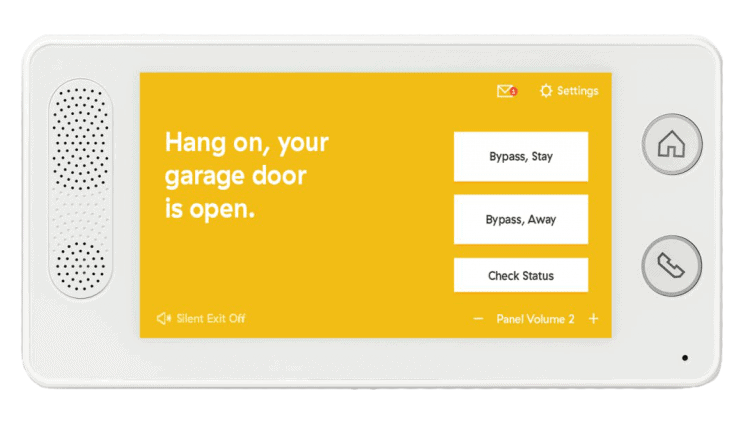
SafeHome.org may receive compensation from some providers listed on this page. Learn More
We may receive compensation from some providers listed on this page. Learn More
Cove is an affordable, feature-rich home security system with monitoring so good I accidentally called the cops on myself.


Sneak Peek Inside: I also appreciated that the Cove Alarm Panel was designed with modern-day living in mind. A lot of “affordable” security providers really skimp on the durability of their components, but not Cove. I stress-tested the Alarm Panel by knocking it off my table a few times and sending it on a tumble down the stairs, but it kept on running like a champ. The screen never cracked, and the functionality never suffered. More than I can say for my iPhone!
When it comes to home security, you have a lot of options, particularly if you go the DIY route. But with so many systems crowding the marketplace, it can be tough to decide which one is right for you.
Don’t worry, I’ve spent countless hours testing and reviewing home security products and systems to determine the best security systems the industry has to offer. And I recently purchased and tested Cove, too.
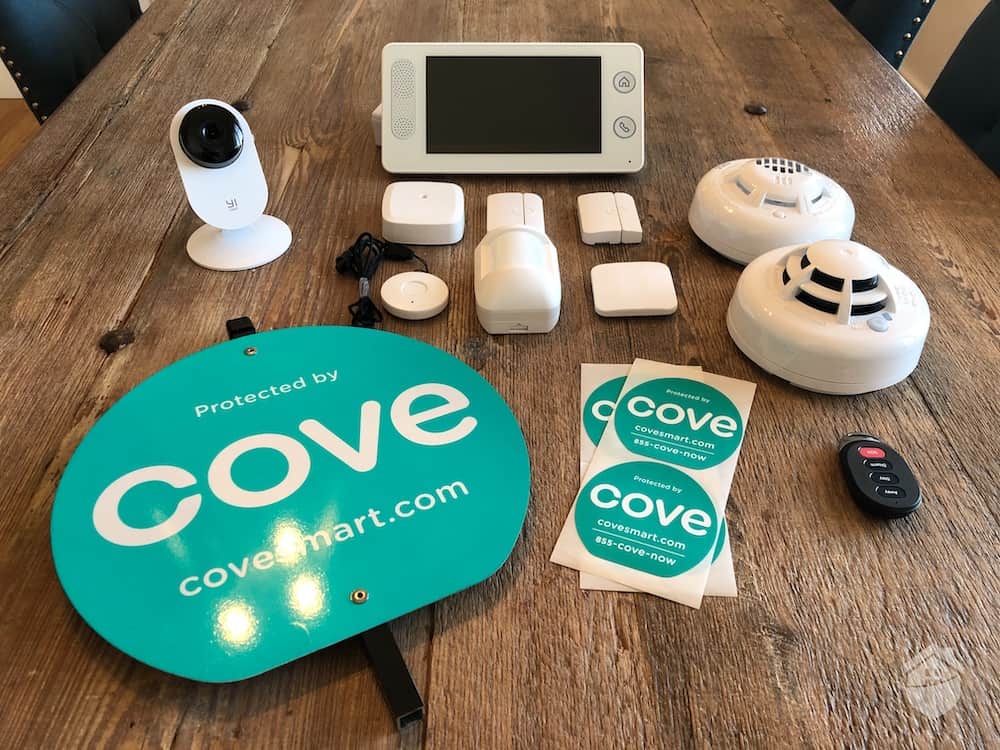
Here’s what everything looked like once I set my Cove system out on my table.
Does Cove make the cut? Will it work for you? We’ll unpack everything Cove has to offer in this review, but before we get going, let me tell you about how I put them to the test.
More on Rob and our SafeHome.org methodology →
The process starts with thorough research of the available options in the market. Our team of seasoned home security researchers looks for brands and systems that offer reliable and effective security equipment and monitoring services. Next, we purchase the ones we want to test, going through the normal buying process for an authentic user experience.
Once the systems are installed, we put them under a microscope. We test all available components and their features, and we even simulate security breaches to see how effectively they react. We also test every company’s customer service, app, and monitoring service.
So now that you understand the process I used to really dig deep into Cove’s offerings, let’s get to it.
Cove has only been around for about 10 years, but they’ve done a lot to change the home security game in the past decade. They offer top-of-the-line equipment that is easy for anyone to install — more on that in just a minute — and their top-of-the-line monitoring will have authorities at your door in no time should an emergency arise — I’ll tell you how I know in just a bit.
On paper, Cove checks a lot of boxes. But does that mean it’s the right home security system for you? Let’s have a look at the pros and cons.
Now that you have an idea of what Cove brings to the table, let’s talk about how you’ll buy your system.
Cove’s purchasing process is pretty interesting. Instead of making you call customer support or picking from a list of products, Cove instead asks you a series of questions about the size of your home, how many entryways you have, how many pets are in the house, and a few other questions to give you a customized system recommendation. Here are my results:

The results of my test on Cove’s website.
You also have the option to adjust the recommended system with a complete list of their products, but providing this starting point is a nice touch. One thing to point out, though, Cove’s website doesn’t really play well with the Firefox browser. If you want to get the best results, use Chrome – it’s a lot more streamlined.
That said, let’s take a look at everything Cove has to offer and, importantly, how much it’s going to cost you.
Cove offers a pretty comprehensive lineup of security equipment. I have more on this in my guide to Cove’s prices, but here’s a quick breakdown of their offerings and what they charge:
| Hub | $150 |
|---|---|
| Touchscreen Panel | $150 |
| Door Sensor | $15 |
|---|---|
| Window Sensor | $15 |
| Motion Sensor | $30 |
| Acoustic Glass Break Sensor | $35 |
| Smoke Detector | $95 |
|---|---|
| Carbon Monoxide Detector | $95 |
| Flood Sensor | $35 |
| Key Fob | $25 |
|---|---|
| Medical Pendant | $20 |
| Eufy Indoor Camera | $59.99 |
|---|---|
| Eufy Doorbell Camera | $99.99 |
| Eufy Outdoor Camera | $129.99 |
Now this isn’t what I’d consider an extensive list. For a system with a lot more equipment options, you might check out my review of Vivint. That company takes a wildly different approach than Cove — it’s all white-glove, professionally installed and super high-tech — but they have an equipment list that’s a mile long.
That said, more isn’t always better. Similar to what I saw when I tested and reviewed SimpliSafe, Cove focuses more on core functionality than added features. When I look at this list, I see a comprehensive security system, nothing more, nothing less.
Once you have your equipment picked out, next you’ll have to think about how you want it monitored.
Cove has two different monitoring packages, and both are relatively affordable for what you’re getting. Here’s the breakdown:
| Feature | Cove Basic | Cove Plus |
|---|---|---|
| 24/7 Monitoring | Yes | Yes |
| Environmental Monitoring | Yes | Yes |
| Alarm Verification | Yes | Yes |
| InstaText | Yes | Yes |
| 24/7 Customer Support | Yes | Yes |
| Dual Connection | Yes | Yes |
| 24-Hour Backup Battery | Yes | Yes |
| Smartphone Control | Yes | Yes |
| Warranty | One-Year | Lifetime |
| Alexa and Google Home Control | No | Yes |
| Camera Support | No | Yes |
| Monthly Cost | $17.99 | $27.99 |
For context, ADT has some of the best professional monitoring in the industry, but you’ll pay significantly more for it than you will with Cove — ADT starts at $24.99 per month and goes up depending on the size of your system and the features you’re looking for. For a home protected by cameras, you’ll pay $34.99 per month with ADT. When you take Cove’s equipment costs and professional monitoring prices into account, it’s easy to see why I included them on my list of the best affordable security systems today.
Pro Tip: The two big differences between Cove Basic and Cove Plus are the voice assistant capabilities and the camera recording functionality. Simply put, if you want either, you’ll have to go with a Cove Plus subscription.
That said, Cove does not show up on my list of the best self monitored systems because you don’t have the option. Although they’re one of the best systems that doesn’t require a contract, you still do have to pick a monitoring package. If you’re interested in the saving self-monitoring brings, I’d say you should check out my review of Ring Alarm. Ring offers comprehensive security equipment you can keep an eye on yourself.
Now that you have an idea of the equipment and the monitoring package you’ll need, let’s talk about my personal experience with my Cove system.
I ordered my system on Tuesday; it was on my doorstep by the end of the week. I appreciated the speedy turnaround time, but I appreciated more how organized everything was packaged. Each of the boxes that each piece of equipment came in was numbered to indicate the order in which I was supposed to open them. Good design like this really inspires confidence.
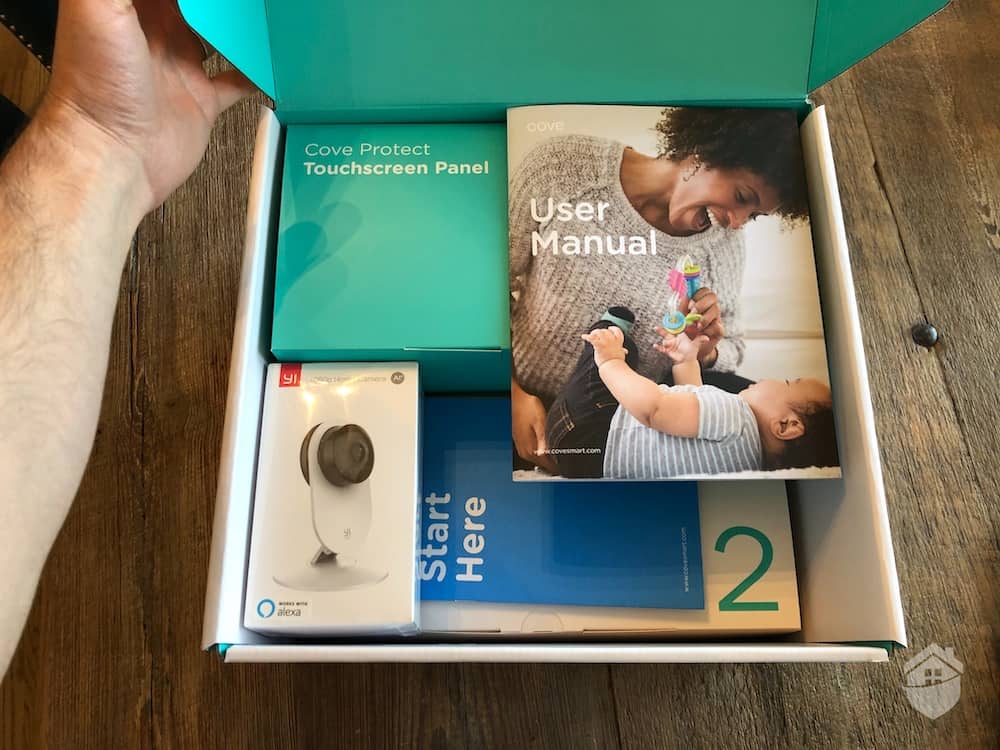
Unboxing the Cove security system for testing.
The first thing that stood out to me was the control panel. It has a sleek look and that satisfying heft I’m always looking for when I check out home security products. It’s well-designed, and I could just tell it would hold up well under daily wear-and-tear. More on that in just a bit.
The next thing I noticed, though, wasn’t exactly to my liking. The entryway sensors were a little bigger than I was anticipating, and they were a little obtrusive after I had them installed. This might just be me nitpicking since I’ve worked with literally hundreds of sensors over my career, but it’s worth pointing out. If you like a slimmer sensor, check out my review of abode. Their sensors are almost unnoticeable once they’re installed.
On the flip side, Cove’s motion sensor is among the smallest I’ve seen. It was a little smaller than my fist, and once I installed it in the corner of my living room, I barely noticed it over the course of my testing. That’s the type of design I’m really looking for.
Now that we’ve had a first look at the equipment, let’s talk about how hard it was to get everything up and running.
While Cove is primarily a DIY security system, you do have the option for professional installation through HelloTech. It starts at $129, but that price will increase depending on the size of the system you purchase. I don’t recommend spending that money, though, since the Cove system is one of the easiest systems to install I’ve encountered in my years of testing.
Is it the best DIY system out there? I don’t think I’d say that, but it’s very close. Like I said in the previous section, everything is packaged in such a way that you know exactly the order to install everything in, and if you follow the enclosed booklet titled “Start Here,” you should be up and running in no time.
FYI: It took me about 15 minutes from unboxing to fully functioning system, which is about on par with SimpliSafe in terms of installation time. If you have zero experience with home security, it might take you closer to an hour. Still, you don’t need to set aside an afternoon or head down to Lowes to buy any specialized tools.
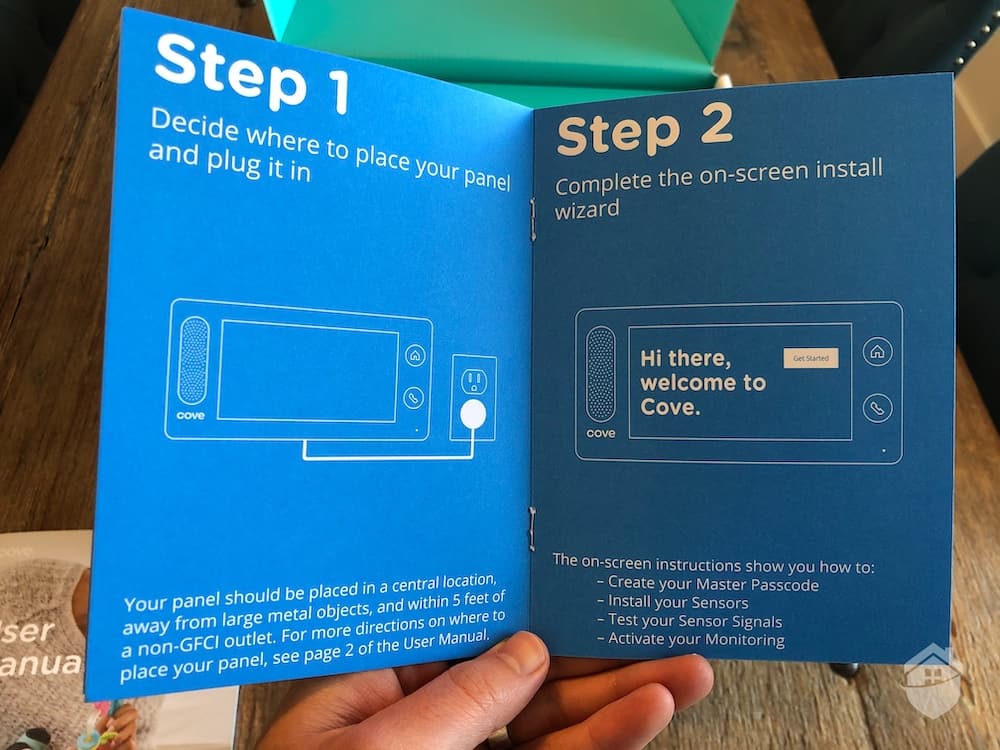
Cove Installation Steps 1-2
You’ll start by plugging in the Cove Hub and connecting it to your router using a provided Ethernet cable. Next, you’re going to plug in the Alarm Panel. The screen is going to turn blue while the device configures, which takes a minute or two. Once it’s done, you’ll get a message that says “Hi, welcome to Cove.”
Once the Alarm Panel is configured, you’ll be asked to set a four-digit master code. You’ll be using this code to access your system in the app or from the control panel itself. I recommend using a code that you’re not likely to forget. Also keep in mind that you’ll be able to add additional users to the system, too, each one with their own access code.
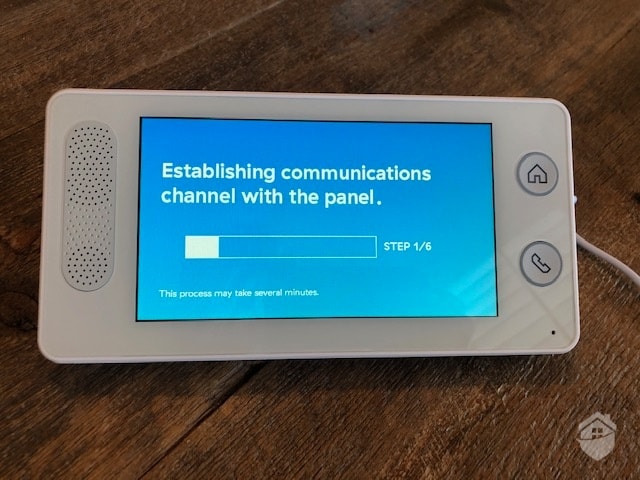
Cove’s control panel during my setup process.
If you answered the questions in Cove’s system setup accurately, you should have enough motion sensors and entryway sensors to cover your home adequately. Now it’s time to set them all up. Like most DIY home security systems, Cove provides 3M adhesive strips on their products to help you stick them in place.
That said, I’m not a huge fan of these. They work well for entryway sensors, but for heavier pieces of equipment like motion detectors, they can be a little flimsy. I recommend replacing the adhesive strips with heavy-duty velcro or permanently affixing everything with mounting hardware, if possible. The last thing you want is for your motion detector to fall while you’re out at the store, creating a false alarm. Ask me how I know.
If your system includes security cameras, now is the time to install them. I have more on this in my guide to installing security cameras, but for the most part you’re going to have a lot of options with the battery-operated Eufy equipment provided by Cove. Make sure your entryways are covered by outdoor cameras, and high-traffic areas are watched by indoor ones. Feel free to test out different configurations, too.
Once you’ve completed these four steps, you should be all set. Let’s take a minute now, though, to talk about each piece of equipment individually.

Cove offers high-quality security equipment at really affordable prices, which I love. But just how well does this equipment hold up? I had my Cove system in my home for about a month, so let me tell you what I found.
Eufy makes some really great cameras, and I’m happy that Cove partnered with them. Let’s start with the indoor camera.
The Eufy Indoor Camera offers 2K resolution, enhanced night vision, and an automatic pan and tilt function that I found really interesting. Essentially if the camera “hears” a sound, it will automatically activate, turn to where the sound came from, and start recording. Don’t worry, though; it’s not going to start recording you every time you cough or if the cat walks through the room. I found that I needed to drop something or stomp through the room for it to activate.
It also has a decent two-way audio function, but I found it could be a little laggy at times. The onboard siren is extremely loud, and I appreciated the ability to store things locally rather than have them uploaded to the cloud.
Keep in mind, this is a plug-in camera, so your mounting options will be a little limited unless you want to run an extension cord through your house. I really prefer battery-operated indoor cameras — you can read about my favorite in my review of the Ring Stick Up Cam — so I hope Cove makes this option available in the future.
The outdoor camera is pretty interesting in its own right. Similar to the indoor camera, it also has an onboard siren, stores data locally, and records in crystal clear 2K resolution. I also liked that it’s solar powered, meaning I didn’t have to plug it in or haul out the ladder to take it down to charge. While that does provide a lot of freedom of where you can install it, I do recommend keeping an eye on its power levels for the first couple of weeks.
The amount of sun it’s going to get changes pretty significantly throughout the day, and you want to make sure you don’t install it in an area that’s shaded the majority of the time. I initially wanted to install mine under the eaves of my garage, but I pretty quickly found out that it wouldn’t work there. I instead had to install it on the wall, just above my door, to make sure it was getting full sun.
This doorbell camera is pretty versatile and is about on par with the Arlo video doorbell I reviewed in terms of functionality and price. Similar to the other two cameras we discussed, it records in 2K resolution, stores video locally, and provides a two-way talk function that allows you to speak with your visitors without opening the door — or getting up from the couch.
FYI: The doorbell camera can be a little laggy, so I didn’t find it good for having full-blown conversations, but it works well enough for telling your delivery driver to leave your food on the stoop.
I also appreciated that I had the option of connecting it to my existing doorbell’s wiring or using battery power. I’m not a big fan of messing with electricity when I don’t have to, but if you want to go the hard-wired route, don’t worry. That installation is pretty easy, too. Just remember to shut the power off at the breaker so you don’t get zapped!
If you don’t have your smartphone handy, the Alarm Panel is where you’ll be interacting with your security system most of the time. It’s not the best panel I’ve ever used — that would be Vivint’s — but it’s definitely up there.
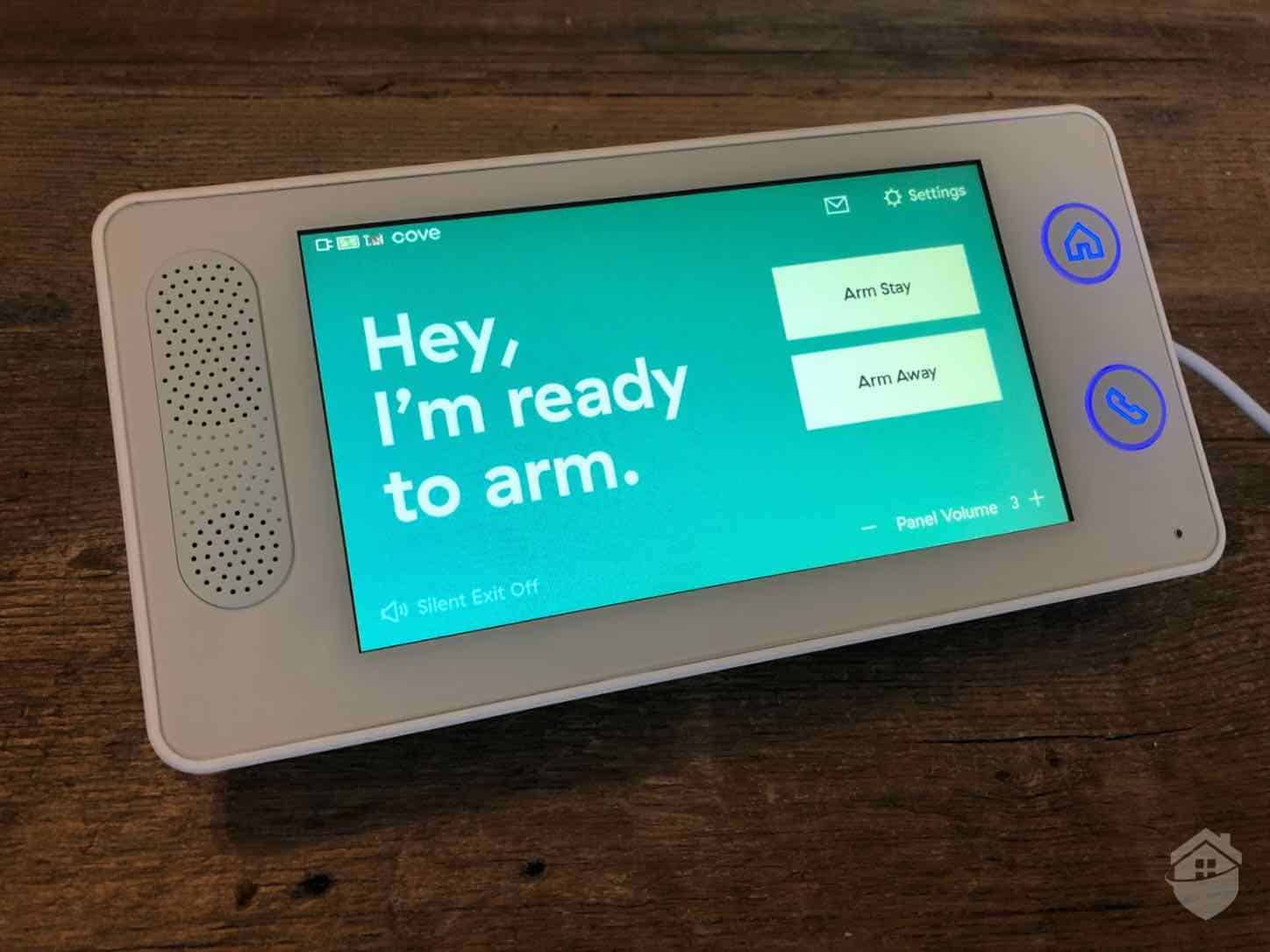
About to arm my Cove system through the control panel.
It’s about 7 inches long, it has a very sleek design, and it has a big touchscreen where you’ll arm and disarm your system and adjust your settings. One feature I liked in particular was the “nighttime mode” setting. During the day there will be a delay which gives you time to enter or leave your home without the alarm going off. In nighttime mode, though, that count-down delay goes away. In an emergency situation, every second counts. You don’t want to give the bad guys a head start.
I also appreciated that this piece of equipment was designed with modern-day living in mind. A lot of “affordable” security providers really skimp on the durability of their components, but not Cove. I stress-tested the Alarm Panel by knocking it off my table a few times and sending it on a tumble down the stairs, but it kept on running like a champ. The screen never cracked, and the functionality never suffered. More than I can say for my iPhone.
Finally, I liked the inclusion of the onboard panic button. The telephone icon, once pressed, will display Police, Fire, or EMS. The service you select will be relayed to the messaging center, and an agent will respond through the panel to provide assistance. If it’s an actual emergency, the agent will dispatch responders and stay on the line with you until help arrives.
The final component class I want to talk about is Cove’s sensors. Like I said above, the entryway sensors are a little on the bulky side for my tastes, but they definitely get the job done. At no point in my testing period did they malfunction or trigger false alarms. It was a bit of a squeeze to mount on my sliding glass door, but there was just enough clearance to make it work.
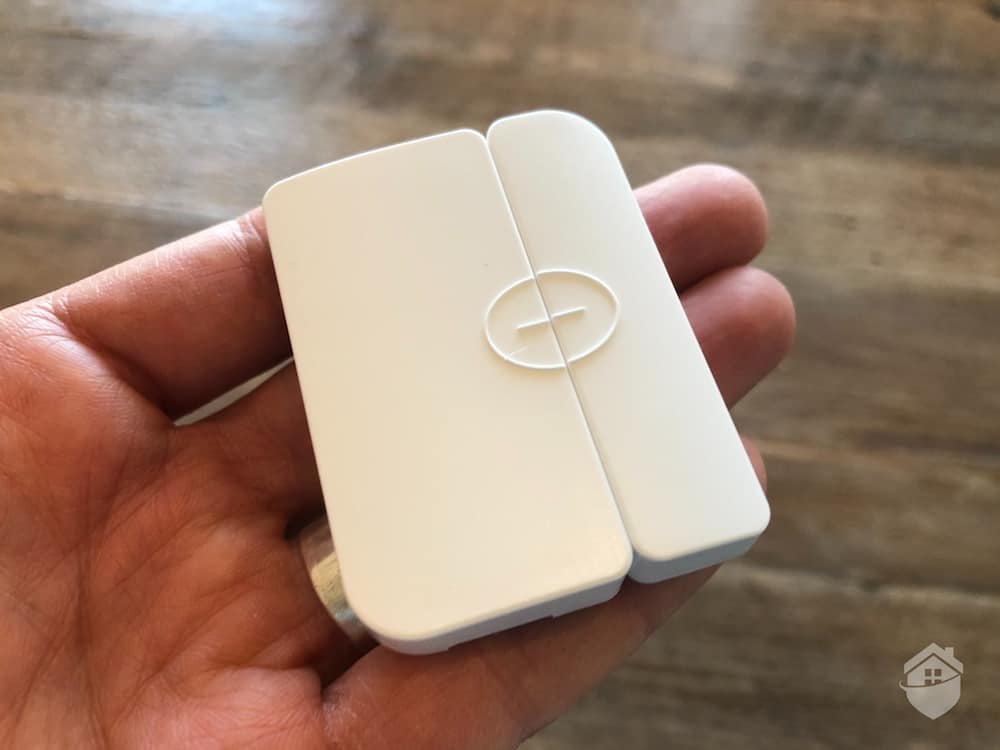
I think Cove’s entryway sensors are a bit too big.
Cove’s motion detector is also well-designed. It’s small and unobtrusive, so it automatically gets bonus points from me, but it’s also calibrated to really reduce false alarms. It only picks up heat signatures from humans, meaning it won’t be triggered by shadows or insects, and it is smart enough to ignore pets below 35 pounds. I have two cats, so it wasn’t an issue. If you have a large dog or, I don’t know, a tiger if you’re Mike Tyson, you might want to be thoughtful about where you place the sensor to minimize it being tripped.
That’s about all there is to say about Cove’s equipment. Overall it was very solid and everything worked as well as I expected it to (even better in some cases). The entryway sensors could use some slimming down, but that’s a minor transgression I’m more than happy to forgive.
Regardless of the subscription package you select, Cove provides you with around-the-clock professional monitoring using the fastest, most reliable connection in the business. The cellular connection provided by the hub — using AT&T’s 4G LTE network — means that your signal won’t be degraded by a poor Wi-Fi signal. In my tests, it never took an agent more than 30 seconds to respond to an alarm.
Pro Tip: Your Cove home security system will keep working even if your power goes out. The hub has a 24-hour backup battery, and since it doesn’t rely on Wi-Fi to communicate with the outside world, you’ll never be without coverage. This is why it’s one of my favorite cellular home security systems.
Also worth pointing out here is Cove’s use of RapidSOS. This is the same technology your smartphone uses to digitally transmit information to 911 dispatchers, making it so you don’t need to relay information to them verbally over the phone. I haven’t seen any other security company utilize this technology, so it really pushes Cove up into the stratosphere in terms of next-gen technology.
So just how good is this monitoring? So good that I accidentally called the police on myself when I was testing it. I wasn’t able to cancel one of the alarms I set off, and in about 15 minutes I had an officer knocking at my door to make sure everything was okay.

The police officer showing up at my door.
I was a little embarrassed and invited him in, explained what I was doing, and told him that I appreciated his help. I also really appreciated how fast Cove’s response times were, but keep in mind your mileage may vary. I live in an urban area very close to a police station. If you live in the country, it might take a while for an officer to respond. Remember, “response time” refers to how quickly a monitoring agent responds to an alarm, not how quickly a police officer will arrive at your home.
Just a few more things to discuss before I give you my final recommendation.
While I really liked Cove’s Alarm Panel, I did find myself controlling the system using my smartphone most of the time. It’s simple, intuitive, and powerful. The user interface is easy to understand, and it’s easy to find and control your system’s settings with a little poking around.
One thing to point out here is Cove’s ability to set up “routines,” which is essentially an IFTTT command. That stands for “If This, Then That,” and you can set up all kinds of responses to certain events. For example, I set a routine that automatically armed my system every night at 10 p.m. so I wouldn’t forget to turn it on and get out of bed. I also set the system to disarm at 7 a.m. so I wouldn’t trigger the alarm when I left half-asleep for my morning walk. The more you work with your system, the more refined you can make these routines.
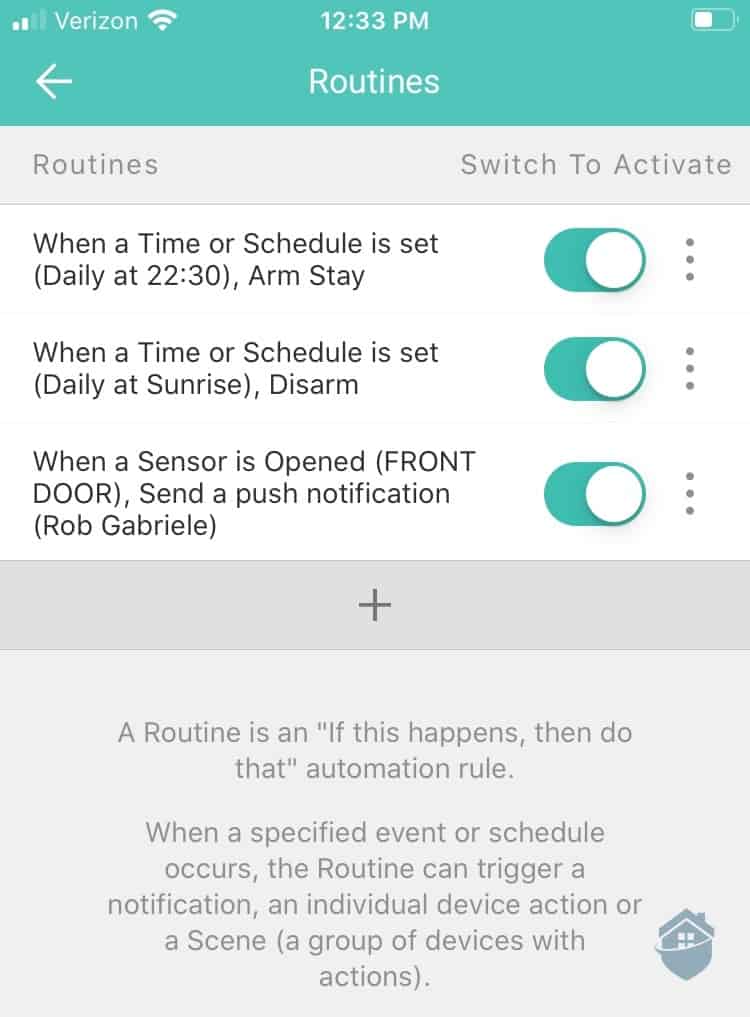
Here are my specialized Cove Routines.
While these routines are really customizable, you are limited to the number of devices you can integrate into your network. Let’s talk about that next, and then I’ll give you my final thoughts.
Put simply, beyond the routines you can set up, there isn’t a whole lot of smart home automation that can be done with your Cove system — primarily because it’s not designed to integrate with other pieces of equipment like smart thermostats or lighting. It’s not a fireable offense by any means, but it’s worth keeping in mind if you want your house to run like the Enterprise.
One integration Cove does allow for, though, is with your Amazon or Google voice assistants. If you want to be able to say “Alexa, arm my system,” from the comfort of your couch, you can. Just make sure you have a Cove Plus monitoring plan, or else you’ll be shouting commands at your walls.
I do wish that Cove had a little more flexibility in terms of automation — that would help people tailor their systems with a little more nuance and control — but overall this is a rock-solid system for people looking for a comprehensive DIY home security solution. You won’t get a lot of bells and whistles here, but in terms of core functionality and value, Cove is tough to beat.
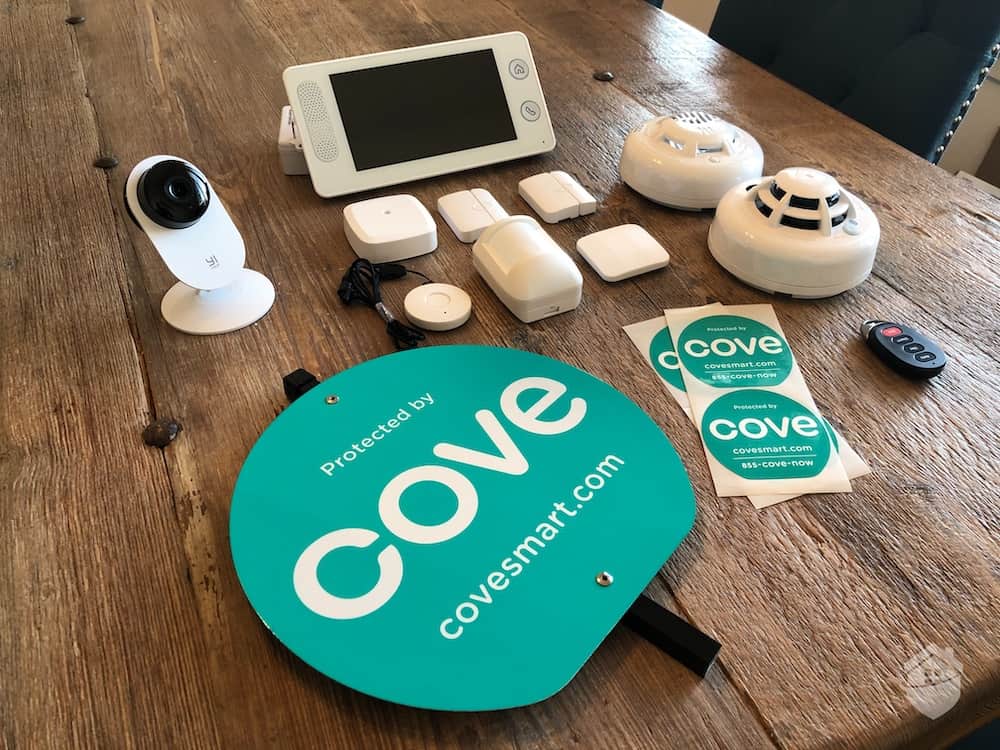
Cove’s equipment.
Would I recommend Cove? It depends on what you’re looking for, honestly. If you’re budget-conscious and don’t mind doing some very light installation to cut down on costs, Cove is probably right up your alley. If you’re looking for a more traditional security experience, you might be a little disappointed. If that’s you, you might consider reading my review of ADT — they’re one of the best traditional systems on the market today.
Yes, Cove is a wireless security system. You’ll have to plug in your hub and your indoor security cameras, but there are no wires that burglars can cut to disable your system.
No, Cove has taken a lot of care to ensure their systems are easy for anyone to install, regardless of how handy they are. Most people will have no trouble getting their system up and running in under half an hour.
Yes, you have the option of including indoor, outdoor, and doorbell cameras to your Cove security package. Cove does not manufacture these cameras, though. They are made by Eufy.
Cove’s monitoring is some of the best in the business. Their response times are quick, and their partnership with RapidSOS makes communicating with first responders more accurate.
One of Cove’s shortcomings is its limited ability to work with third-party smart home devices. While you can use voice commands with Alexa and Google Assistant and set up routines using the Cove app, I wouldn’t consider this an automated system.